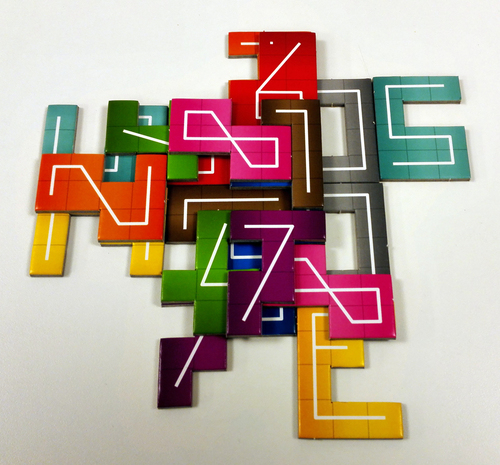
NUMBR 9 is a pretty simple game to understand. It’s essentially a stacking game, whereby you draw a card from the deck, find the numbered tile in the box that corresponds to that number and place it onto your stack. The higher your stack is, the more points you win, and the more likely you are to win the game.
If only it were that simple.
It’s both the rules of your tile placement and the shapes of the tiles themselves which make this tough, and give you far more to think about than you originally imagine. Placing your tiles can happen in one of two ways: either on an existing level, or by creating a new one. Drop it onto an existing level and it needs to touch at least one other tile; try to place it onto a higher level and it not only needs to still touch another tile on that level (unless it’s the first one) but also can’t overhang the edge of a tile below, so any gaps you have on your lower levels start to come back to haunt you. It’s a tricky balancing act between forming a solid base without gaps, and getting some tiles onto higher ground.
And that higher ground is vital. You score points by multiplying the tile value by the layer it’s on, and as the lowest level doesn’t count you need to get stacking pretty quickly. So as an example, one player might have a 5 and a 7 on their first layer up, and scores 12 points as a result (5×1, plus 7×1). Meanwhile the second player has focused on getting up to their second level, where scores are multiplied by 2 instead, so their carefully positioned 8 has already grabbed them 16 points (8×2) as well as whatever points crop up from those numbers on the first level. It’s a tough thing to explain without sitting in front of the game, but the main premise is this: get your numbers as high as possible, and pray that a 9 comes up at just the right time. Hit the jackpot with a high card at the right time, and it’s as good as game over.

Despite the mental arithmetic needed to play this well, it’s a pretty short game. Typically we found it was done and dusted in about 20 minutes, and upping the player count doesn’t really extend the game length all that much, mainly down to the fact that everyone is just trying to get their scores as high as possible. You draw a 5, everyone positions a 5. You draw a 1, everyone gets a 1 from the box. It’s basically a multiplayer solitaire game, and while that means there’s no unpleasantness between players when someone starts getting lucky by getting a higher number than everyone else, it certainly reduces the interaction between players.
And that’s what I found the most difficult thing to enjoy. The game itself is pretty decent, and the concept of stacking your tiles in a way that meant any gaps on your layers got punished pretty quickly certainly gave it a difficult edge that was every bit as much of a fun challenge as anything else. It just would’ve been nice to somehow have more meaning to bringing some other players into the game. Yes, you compare scores at the end to find a winner, but that’s all there is.
So if you’re after an enjoyable stacking game to play by yourself or with some friends then this is still worth a look, but don’t go into it expecting to be laughing the house down by the end – this is more a quiet thinkers game, but still a very enjoyable one.

Leave a Reply